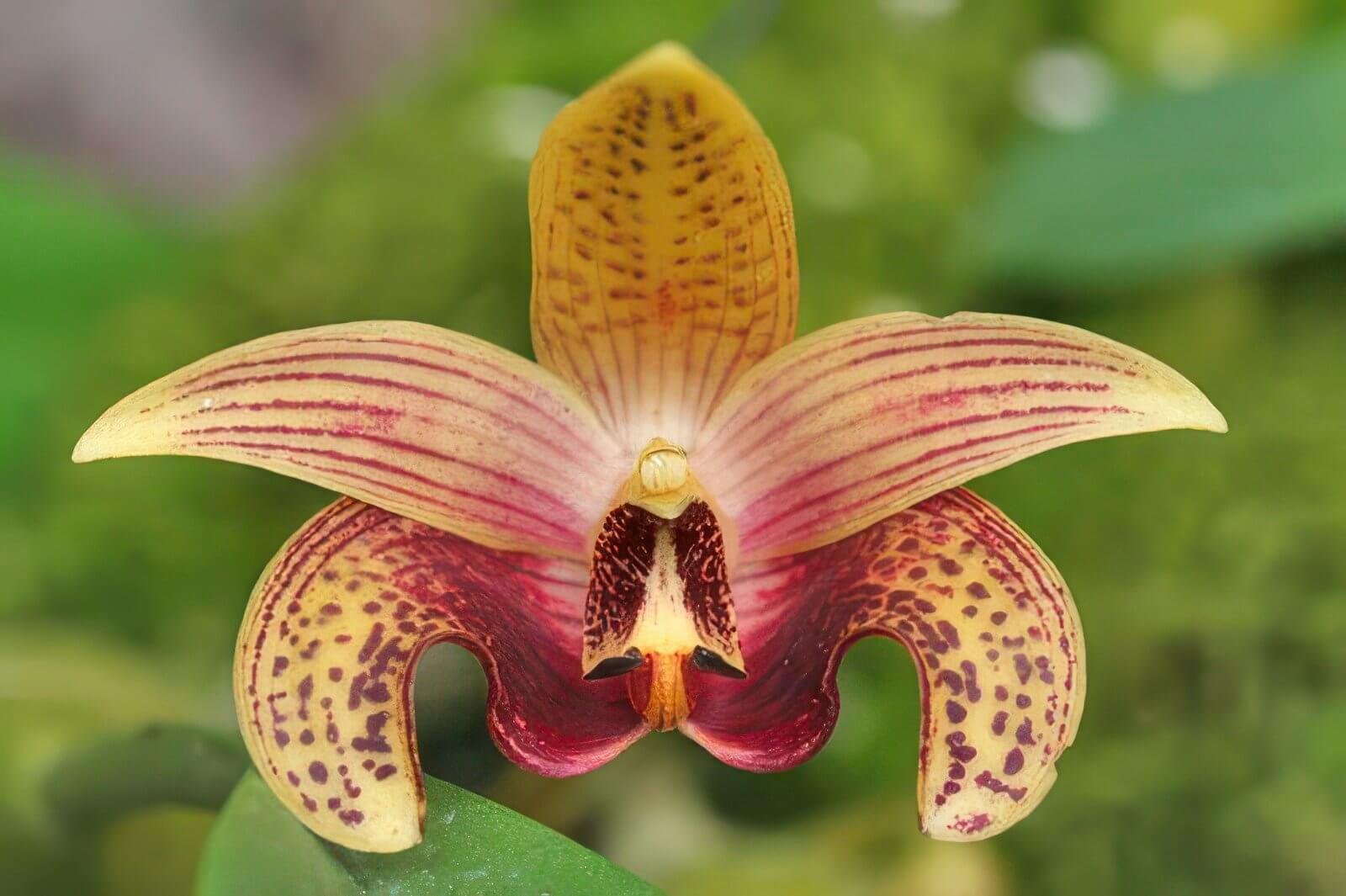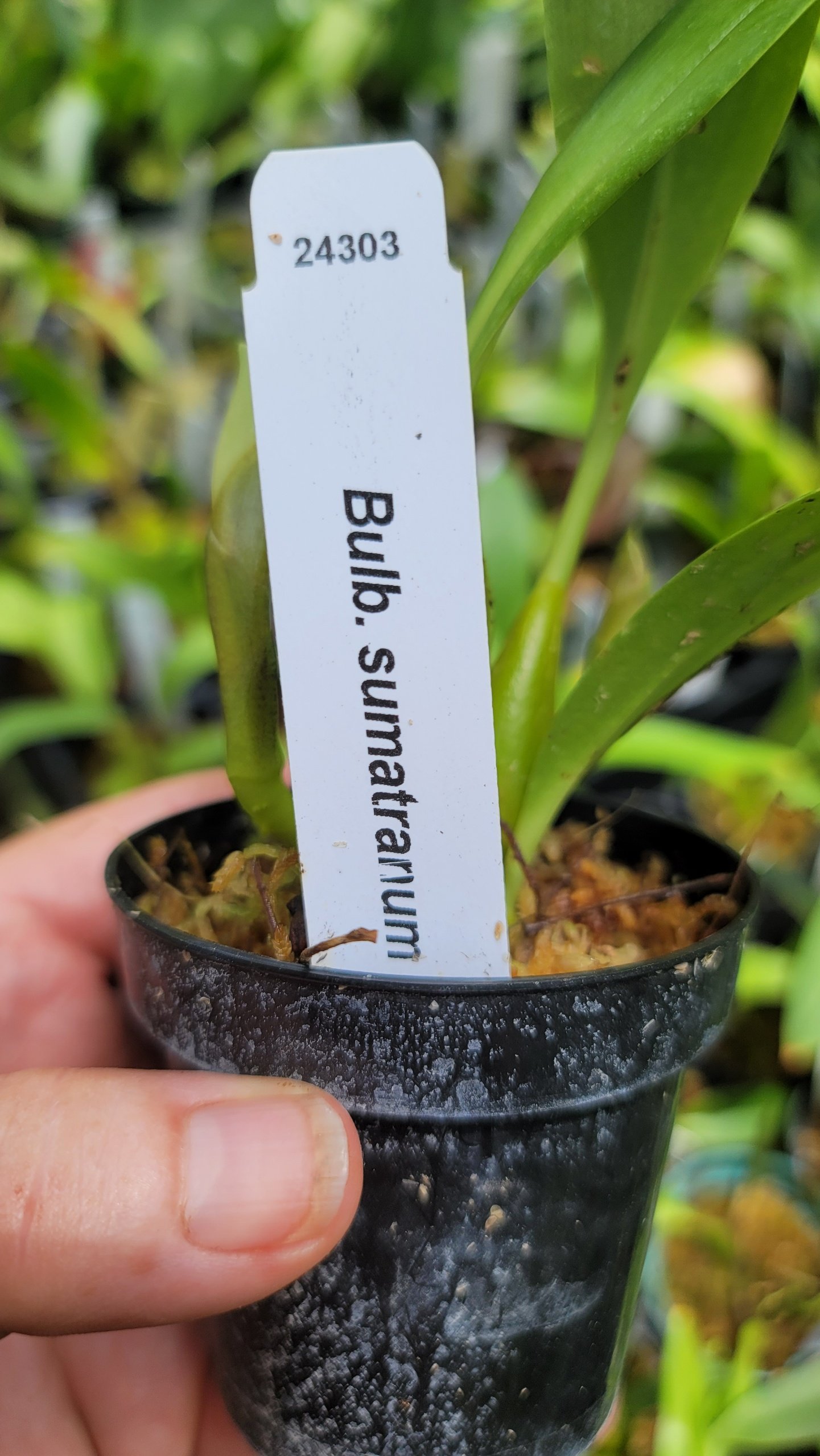 Image 1 of 2
Image 1 of 2

 Image 2 of 2
Image 2 of 2



Cattley (Laelia) purpurata var. schusteriana
Cattleya purpurata var. schusteriana (‘Linwood’ AM/AOS x Orchid Eros’ AM/AOS).
Cattleya purpurata was first described by John Lindley and Joseph Paxton in 1852. Previously classified under Laelia purpurata before Laelia and Cattleya were merged based on genetic evidence in 2008. The variety schusteriana is one of many recognized color variants within the species. Endemic to southern Brazil, primarily Rio Grande do Sul and Santa Catarina, in coastal forests and nearby highlands. Grows epiphytically on trees or as a lithophyte on rocky outcrops at elevations of 100-1,200 meters, in humid, seasonally dry climates.
Cattleya purpurata is Brazil’s “Queen of Orchids,” and schusteriana adds a rare blue-toned jewel to its crown. It’s less common than alba or flamea forms and cherished by enthusiasts. We have Blooming Size plants well established in 4-inch pots. Our plants are seed grown so each is unique, bred from select awarded parents (Linwood’ AM/AOS x Orchid Eros’ AM/AOS). Plants are fully acclimated to outdoor growing in South Florida.
Plant Structure:
A unifoliate epiphyte with elongated, cylindrical pseudobulbs (20-40 cm tall), each bearing one rigid, leathery leaf (15-30 cm long).
Growth habit is upright and robust, typical of large-flowered Cattleya species.
Flowers:
Size: Large, 12-20 cm (5-8 inches) across, among the biggest in the genus.
Color: The schusteriana variety is distinguished by its unique coloration. While Cattleya purpurata typically has rose-lavender to deep purple petals and sepals with a darker purple lip and yellow throat, schusteriana is often cited as a coerulea-like form—featuring pale bluish-lavender petals and sepals with a deeper blue-purple lip. Exact shades vary, but it leans toward cooler tones compared to the warmer pinks of the type form.
Shape: Broad, flat petals and sepals with a prominent, trumpet-shaped lip that’s ruffled at the edges—a hallmark of C. purpurata.
Count: 2-6 flowers per inflorescence, emerging from a terminal sheath on new growths.
Fragrance: Strongly fragrant, with a sweet, floral scent often likened to roses or citrus, consistent across C. purpurata varieties including schusteriana.
Cattleya purpurata var. schusteriana (‘Linwood’ AM/AOS x Orchid Eros’ AM/AOS).
Cattleya purpurata was first described by John Lindley and Joseph Paxton in 1852. Previously classified under Laelia purpurata before Laelia and Cattleya were merged based on genetic evidence in 2008. The variety schusteriana is one of many recognized color variants within the species. Endemic to southern Brazil, primarily Rio Grande do Sul and Santa Catarina, in coastal forests and nearby highlands. Grows epiphytically on trees or as a lithophyte on rocky outcrops at elevations of 100-1,200 meters, in humid, seasonally dry climates.
Cattleya purpurata is Brazil’s “Queen of Orchids,” and schusteriana adds a rare blue-toned jewel to its crown. It’s less common than alba or flamea forms and cherished by enthusiasts. We have Blooming Size plants well established in 4-inch pots. Our plants are seed grown so each is unique, bred from select awarded parents (Linwood’ AM/AOS x Orchid Eros’ AM/AOS). Plants are fully acclimated to outdoor growing in South Florida.
Plant Structure:
A unifoliate epiphyte with elongated, cylindrical pseudobulbs (20-40 cm tall), each bearing one rigid, leathery leaf (15-30 cm long).
Growth habit is upright and robust, typical of large-flowered Cattleya species.
Flowers:
Size: Large, 12-20 cm (5-8 inches) across, among the biggest in the genus.
Color: The schusteriana variety is distinguished by its unique coloration. While Cattleya purpurata typically has rose-lavender to deep purple petals and sepals with a darker purple lip and yellow throat, schusteriana is often cited as a coerulea-like form—featuring pale bluish-lavender petals and sepals with a deeper blue-purple lip. Exact shades vary, but it leans toward cooler tones compared to the warmer pinks of the type form.
Shape: Broad, flat petals and sepals with a prominent, trumpet-shaped lip that’s ruffled at the edges—a hallmark of C. purpurata.
Count: 2-6 flowers per inflorescence, emerging from a terminal sheath on new growths.
Fragrance: Strongly fragrant, with a sweet, floral scent often likened to roses or citrus, consistent across C. purpurata varieties including schusteriana.
Cattleya purpurata var. schusteriana (‘Linwood’ AM/AOS x Orchid Eros’ AM/AOS).
Cattleya purpurata was first described by John Lindley and Joseph Paxton in 1852. Previously classified under Laelia purpurata before Laelia and Cattleya were merged based on genetic evidence in 2008. The variety schusteriana is one of many recognized color variants within the species. Endemic to southern Brazil, primarily Rio Grande do Sul and Santa Catarina, in coastal forests and nearby highlands. Grows epiphytically on trees or as a lithophyte on rocky outcrops at elevations of 100-1,200 meters, in humid, seasonally dry climates.
Cattleya purpurata is Brazil’s “Queen of Orchids,” and schusteriana adds a rare blue-toned jewel to its crown. It’s less common than alba or flamea forms and cherished by enthusiasts. We have Blooming Size plants well established in 4-inch pots. Our plants are seed grown so each is unique, bred from select awarded parents (Linwood’ AM/AOS x Orchid Eros’ AM/AOS). Plants are fully acclimated to outdoor growing in South Florida.
Plant Structure:
A unifoliate epiphyte with elongated, cylindrical pseudobulbs (20-40 cm tall), each bearing one rigid, leathery leaf (15-30 cm long).
Growth habit is upright and robust, typical of large-flowered Cattleya species.
Flowers:
Size: Large, 12-20 cm (5-8 inches) across, among the biggest in the genus.
Color: The schusteriana variety is distinguished by its unique coloration. While Cattleya purpurata typically has rose-lavender to deep purple petals and sepals with a darker purple lip and yellow throat, schusteriana is often cited as a coerulea-like form—featuring pale bluish-lavender petals and sepals with a deeper blue-purple lip. Exact shades vary, but it leans toward cooler tones compared to the warmer pinks of the type form.
Shape: Broad, flat petals and sepals with a prominent, trumpet-shaped lip that’s ruffled at the edges—a hallmark of C. purpurata.
Count: 2-6 flowers per inflorescence, emerging from a terminal sheath on new growths.
Fragrance: Strongly fragrant, with a sweet, floral scent often likened to roses or citrus, consistent across C. purpurata varieties including schusteriana.
Growing Conditions
Light: Bright, indirect light (2,500-4,000 foot-candles). Tolerates morning sun but needs filtering in harsh climates.
Temperature: Intermediate to warm, 60°F-85°F (15.5°C-29°C). Handles cooler nights (50°F/10°C) during winter rest.
Humidity: 50%-80%. Higher humidity aids growth, especially in summer.
Watering: Water thoroughly when the medium (coarse bark or mounted) dries—weekly in summer, biweekly in winter during dormancy. Avoid water pooling in sheaths.
Fertilizer: Weekly 1/2 strength orchid fertilizer (e.g., 20-20-20) during growth (spring-summer), reduced in fall-winter.
Blooming
Season: Late spring to summer (May-August in the Northern Hemisphere), occasionally extending into fall.
Trigger: A dry rest in late winter/early spring (reduced watering after pseudobulbs mature) followed by increased light and water as new growths emerge.
Duration: Flowers last 3-5 weeks, longer in cooler, humid condition
Care Tipe:
Potting: Use coarse bark or mount on cork/wood for drainage and air exposure. Repot post-blooming when new roots start.
Rest Period: Critical for flowering—reduce water in winter, resuming with spring growth.
Pests: Watch for scale or mealybugs, common in Cattleya species, though not unusually prone.








